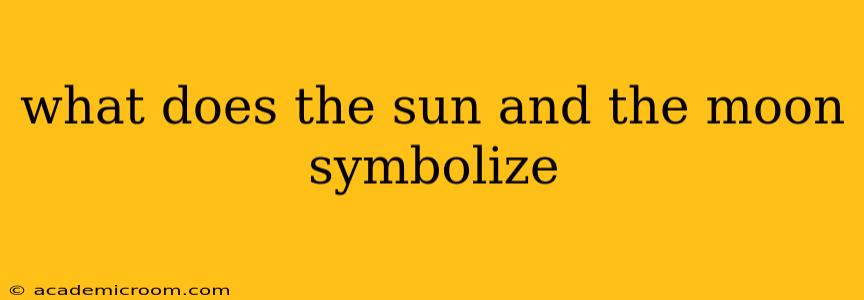What Do the Sun and the Moon Symbolize? A Deep Dive into Celestial Symbolism
The sun and the moon, two celestial bodies fundamental to life on Earth, have held profound symbolic meaning across cultures and throughout history. Their contrasting natures—one a blazing source of light and life, the other a mysterious orb reflecting borrowed light—lend themselves to a rich tapestry of interpretations. This exploration delves into the diverse symbolism associated with the sun and moon, examining their multifaceted representations in mythology, religion, and art.
What Does the Sun Symbolize?
The sun's symbolism overwhelmingly centers around life, energy, and power. Its radiant warmth and life-giving light have made it a universal symbol of creation, divinity, and the source of all things. Different cultures have expressed this symbolism in various ways:
-
Power and Authority: In many ancient societies, the sun was associated with kings and emperors, representing their authority and divine right to rule. The sun's unwavering presence in the sky mirrored their perceived permanence and power.
-
Masculinity and Strength: Across numerous cultures, the sun is linked to masculine energy, representing strength, virility, and dominance. This association is often reflected in mythological figures depicted as sun gods, embodying these qualities.
-
Consciousness and Awareness: The sun's illuminating qualities have also led to its association with consciousness, knowledge, and spiritual enlightenment. It represents clarity, truth, and the awakening of the soul.
-
Growth and Rebirth: The sun's cyclical journey across the sky, rising and setting each day, mirrors the cycle of life, death, and rebirth. It symbolizes growth, renewal, and the continuous cycle of creation and destruction.
What Does the Moon Symbolize?
Unlike the sun's radiant dominance, the moon's symbolism is more nuanced and multifaceted, often associated with mystery, intuition, and the feminine. Its cyclical phases mirror the ebb and flow of life, reflecting the mysteries of the subconscious and the ever-changing nature of reality:
-
Femininity and Intuition: The moon is frequently linked to feminine energy, representing intuition, emotion, and the cyclical nature of womanhood. Its phases mirror the menstrual cycle, emphasizing the connection between the celestial body and the female experience.
-
Mystery and the Unknown: The moon's enigmatic nature, its phases shifting and changing, has often led to its association with the unknown, the subconscious, and the mysteries of the night. It represents the hidden aspects of ourselves and the world.
-
Cycles and Change: The moon's phases—new moon, waxing crescent, full moon, waning crescent—symbolize the cyclical nature of life, death, and rebirth. It represents the constant flux of change and the passage of time.
-
Dreams and the Subconscious: The moon's nocturnal presence has often connected it to the world of dreams and the subconscious. It represents the realm of intuition, imagination, and hidden emotions.
What is the symbolism of the sun and moon together?
The combined symbolism of the sun and moon often represents the balance of opposites, the unification of seemingly contradictory forces, or the harmonious interplay between masculine and feminine energies. This union often symbolizes:
-
Yin and Yang: In many Eastern philosophies, the sun and moon embody the principles of yin (feminine, passive) and yang (masculine, active), representing the complementary nature of these forces and their essential balance.
-
Complementary Opposites: Together, they show how opposing forces are necessary and interconnected, creating a dynamic equilibrium.
-
Unity and Wholeness: The sun and moon together represent the completion of a cycle, the integration of opposites, and the attainment of wholeness.
How is the sun and moon symbolism used in different cultures?
The symbolism of the sun and moon varies across cultures, reflecting their unique beliefs and experiences. For example:
-
Ancient Egypt: The sun god Ra was central to Egyptian religion, representing creation and power. The moon, associated with Thoth, the god of wisdom and magic, represented the mysteries of the night and the cyclical nature of time.
-
Native American Cultures: Many Native American tribes had distinct sun and moon deities, often representing complementary forces within their creation myths.
-
Celtic Culture: The sun and moon were central to Celtic mythology, with solar deities associated with power and lunar deities associated with fertility and wisdom.
Understanding the symbolism of the sun and moon offers a fascinating glimpse into the human experience across time and cultures. Their enduring presence in our skies continues to inspire awe, wonder, and a deep reflection on the mysteries of the universe and the human condition.
